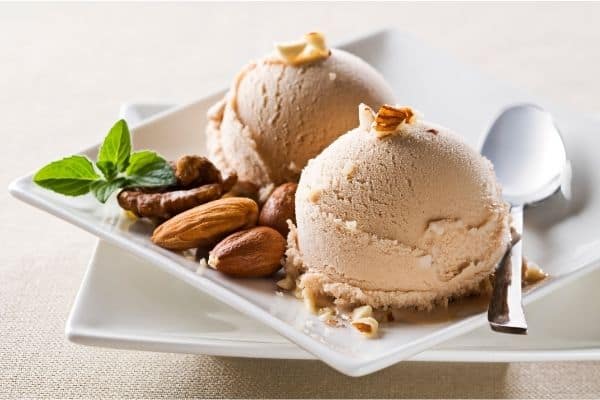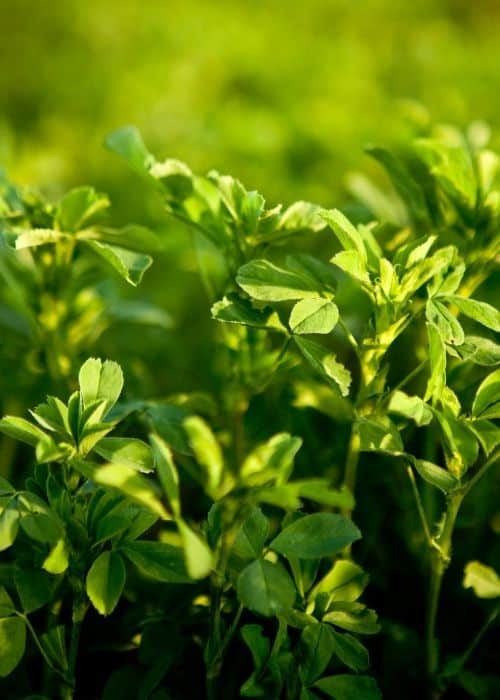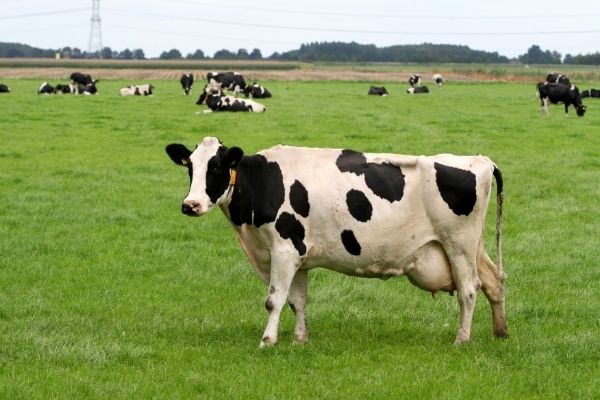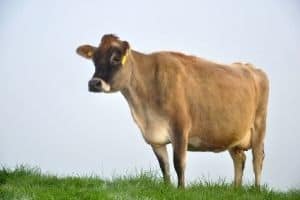Dairy farms are an essential part of agriculture in the United States. They make more than just milk, with many dairy farmers producing and selling cheese, yogurt, and butter with their cow's milk, and eventually even meat from the retired cows.
Dairy farmers can make anywhere from $15,000 to $120,000+ a year, with an average of about $43,000 yearly. To understand how much dairy farmers make in a year, it's important to compare the costs of running the dairy farm with the profit of selling products. This allows for a widespread of income across dairy farmers.
There are many factors to take into account when determining the income for dairy farms. Read on to discover precisely how much dairy farmers make in a year.
How Much Do Dairy Farmers Actually Make?
The amount of money that a dairy farmer makes will vary widely based on several factors. The industry average for a dairy farm owner in the United States is around $43,000 per year. This equates to a little over $21 per hour.
However, according to ZipRecruiter, most dairy farmers (59%) make between $24,500 and $43,000 annually.
As a first-time farmer, you may not make the median. Mistakes may set you back, and you may not be prepared for everything. You can easily have natural disasters or other mishaps that will put you back both in production and financially.
Some dairy farmers can make around fifty thousand dollars or a little more. It can be less, depending on your investments and the cost of living wherever your farm is located.
This number can vary based on many factors, some of which include:
As with all businesses, the income is what's left of money from your product after you've paid overhead and other associated costs.
Money is made on the milk product and also the cows themselves. Expenses range from feed and transport to veterinary care and maintaining equipment while paying workers.
How Much Do Dairy Farms Make Per Cow?
Larger dairies with more cows produce more milk, bringing in a more considerable income. Conversely, the smallest dairies also bring in a better income. Wisconsin State Farmer explains how this can be the case.
This discrepancy is because, in the 200-500 range, companies need to start mechanizing more and hiring more workers, which detracts from their profit. The smaller herds require less workforce and remain profitable, while the large herds produce enough to offset the costs of increased workers and other overhead.
The "in-between" size dairy farms generally struggle more than large- or small-scale operations.
Best States for Dairy Farmers To Earn money
Delaware is leading in the list of states where dairy farmers earn the most income, around $50,000 a year, based on our research.
Ohio comes at a close second and had been the number one paying state in previous years. It still averages around fifty thousand dollars but still a few dollars short compared to Delaware.
Here are the top 5 states where dairy farmers make the most, ranging between $45,000 and $54,000:
There are many things to take into consideration when comparing income. What are the costs? Is the cost of living higher than in other states?
This can make a difference in what a dairy farmer ends up earning.
How Much Does Milk Sell For?
The majority of the money made at a dairy farm comes from milk, but you may be surprised at how much milk actually sells for.
The actual price of milk is relatively low. Generally, milk is sold in units of hundredweight (100 lbs.) and classified as cwt. These prices vary depending on the class and type of milk sold. Below is a table with a few examples.
Milk Classification | Price Per Hundredweight |
|---|---|
Class 1- Base Price | $18.29 |
Skim Milk- Base Price | $11.82 |
Class 2- Skim Milk | $10.12 |
Advanced Class 3- Skim Milk | $12.73 |
Class 4- Skim Milk | $9.42 |
Source: USDA
As you can see, the highest dollar amount is made from class 1 base milk, and skim tends to provide less income. Advanced classes are usually used for making different products and can bring more revenue.
The low price of each 100 pounds of milk means that a lot of milk needs to be produced in order to make a profit. Dairy farmers have adjusted their production practices over the years to maintain profitability within their business, and breeds have been selected specifically for their milk production capacities.
Luckily, cows produce a lot of milk. The average dairy cow can produce around 70 pounds of milk per day, which is about 8 gallons. A dairy cow will produce about 2,500 gallons of milk in a year, which is about 23,000 pounds of milk.
Dairy Farmers Can Make Money on Other Milk Products
When thinking of a dairy farm, most people's first thought is milk. There are lots of other products that come from their dairies and many products in addition to milk sold for profit.
Depending on the breed of cattle, the amount produced, and nutrient levels in the milk, some dairy farmers offer additional products other than the Class 1 drinking milk. These include:

Eggnog
Class 1
Fluid use, eggnog, etc.

Ice Cream
Class 2
Soft products like ice cream, sour cream, custards, and puddings

Organic Cheese
Class 3
Cheeses; spreadable like cream cheese and other hard cheeses to be crumbled or shredded

Butter
Class 4
Milk powder, butter, evaporated or condensed milk
The Federal Milk Marketing Orders (FMMO) determine the prices of the milk products with the USDA. These are based on region and provide different prices for each of the classes. By law, the dairy producers have to be paid the minimum amount set by FMMO.
There are many other options for dairy farmers to make a profit from other than only plain milk, and many dairies sell several products to increase their income.
Is Selling Cows Profitable for Dairy Farmers?
Dairy farmers can also see a profit in selling off their producing dairy cows. Lactating dairy cows can sell for anywhere from $300-$2,000 per cow, depending on several things. These can vary due to:
Calves that are born in a dairy can bring in supplemental income as well. Many of the males are sold off for veal or beef. The females are either used to continue dairy production, grow the herd, or sold to other dairies for $450 to $600 per calf. They may also be sold by the weight.
Many of these dairy calves are also bought to start growing a beef cattle herd for farmers who raise their animals for meat instead of dairy.
Farmers will see income from selling off their calves, depending on the size of their herd. Dairy cows must become pregnant in order to produce milk. Often, the cows are artificially inseminated yearly, and then the calves are removed quickly so that the farmers can continue milking the cows. The average dairy cow will produce one calf each year and has a lactation (milk-producing) cycle of 305 days.
How Do Dairy Farmers make income when Their Cows Stop producing milk?
Once dairy cows are "retired" after several years (7, on average), there are different routes to take. The lucky ones are put out to pasture to live out the rest of their days, while some are rescued or go to smaller family farms. Other retired dairy cows are sold for meat. They can become any of the following:
This is the most economically viable option, as many dairy cows can live over 20 years. Feeding and caring for cows for up to 13 years past their "prime" does not make financial sense. So, when they have begun a decline in milk production, they will be replaced by a younger, higher-producing cow.
It may seem cruel, but dairy farms are a business just like any other, and profitability hinges on decisions like these.
How Much Do Dairy Farms Cost to Operate?
Dairy farms can be expensive to run, compared to how little the milk sells for. Several things cost money for dairy farmers. Dairy farmers do their best to lower or mitigate these costs, but the size of the herd will affect each of these costs for the dairy farm directly.
These factors include:
Dairy Farmers Have to Feed Their Cows
With the current dairy climate, dairy farmers are most interested in producing a large amount of milk for a small price, thereby increasing their income.
To do this, many have turned to supplementing with grain-fed cows,
You do not want to skimp and buy cheap food. Unhealthy cattle food can make the cows sick and can even disrupt the production of milk.
Growing or buying high-quality feed will keep your cattle’s health wonderful. You will have better products from them by paying for more all-natural (and more expensive) feeds such as:

Hay
The most cost-effective way to feed dairy cows has become grain added into hay. Holstein cows, the most popular dairy cows, process grain quickly and effectively. This cuts down on feeding price by doing several things:
By adjusting the feeding process, dairy farmers can add to their bottom line and increase their income.

Alfalfa
Farmers also grow their own alfalfa and hay to feed their cows. This can be more cost-effective with a good system. Growing and maintaining fields add to the dairy's workload, but some prefer to feed their cows from the farm itself.

Grass
At Family Farm Livestock, they break down the cost of annual feed. Dairy cows can eat around 100 pounds a day while they are producing milk. If hay is bought, it will cost about $1,000 per year per cow. If the cattle are grazing in fields, the additional cost of grain should only be around $200-$300 annually per cow.
It is recommended to have 1.5 to 2 acres per cow to maintain the appropriate feed for grazing.
Startup Costs for a Dairy Farm Are High
As with most businesses, the initial investment is high. Dairy farmers have to provide several things immediately for their cows, including:
Buying dairy cows to start a dairy will depend on the size of the herd needed. Dairy Cows that are already producing average amount of milk can be acquired for anywhere from $900 to $3,000.
Adding in the costs for feed, vet care, buildings, utilities, employees, and leasing land, starting a dairy can be expensive ProfitableVenture breaks down the expenses.
Small-scale, family-run dairy farms with a few cows can be started for around $30,000. In contrast, larger, mass-production dairy farms can easily run over a million dollars total and will likely be closer to 3 million dollars
The initial investment for dairy cows can be hundreds of thousands of dollars. If you're buying or leasing land for cows, expect to provide 1.5-2 acres per cow, which can add up quickly with a large herd.
With the extensive startup costs for a dairy, it may take more time to see a profit.
Dairy Farmers Have to Pay Workers
If the dairy is larger, you will need farmhands to help you with daily tasks. As with any industry, the farmers will need to pay for workers at their farms. These vary based on the US region where the dairies are, but generally, ranch hands on dairies are paid between $9.35 to $22.20, with the median wage of $14.93 according to the U.S. Bureau of Labor Statistics.
How Much Do Farmers Spend on Cows?
The breed of cows that a farmer chooses for their dairy herd will determine the farm's output. The initial costs of these breeds vary, as do their production level and advantages over other breeds.
There are currently seven common breeds used in US dairy farms. Each of these cows has its pros and cons. Below is a chart comparing the most common dairy breeds.
Breed | Cost to buy ($) | Production/cycle each year (gallons) | Breed Advantage |
|---|---|---|---|
 Holstein | 1,000-1,200 | 2,674 | High producing |
 Jersey | 1,400-1,800 | 2,190 | High quality fat and protein content |
 Red & White Holstein | 1,000-1,100 | 2,900 | Good immune system, hardy breed |
 Guernsey | 900-3,000 | 1,580 | High in Vitamin A, very nutrient-dense milk |
 Brown Swiss | 800-1,500 | 2,000 | Great for most cheeses |
 Ayrshire | 2,800-3,200 | 3,000 | Efficient producers, low feed/high volume |
 Shorthorn | 1,200-1,800 | 2,700 | Used for milk or beef, can be both |
(Sources: MidWest Dairy and Michigan State University)
There are many different types of dairy cows, and depending on the dairy farm's goals, the breed of cattle chosen for the herd will vary.
High-producing cattle like Holsteins are suitable for larger-scale dairies because they have a high output. Their milk is less nutritionally dense, so that it will sell for a lower classification. These are the most common breed in the US, with over 90% dairy cows being Holsteins.
Breeds like Guernsey, Brown Swiss or Ayrshire are more expensive to buy, but their milk produced has a denser nutritional value and can bring in more money per hundredweight.
Changes in the Dairy Farming Community
There has been a recent swing in dairy farming from giant dairy farms back to smaller-scale operations. This has been out of necessity, with the drastic changes in the field of dairy farming since the 1990s.
Dairy Farmers Have Had to Adjust
While most dairy farms continue to be large-scale productions, the field has seen a definite shift toward smaller, organic dairy farms. Cutting down on the number of dairy cows decreases overhead, and increasing the price of products generates more income for dairies.
To charge more for their product, dairy farmers are transitioning to supplying premium, organic milk from grass-fed, free-range cows and are finding this to be more financially viable and sustainable, and more well-received by the general public.
This higher quality milk can be sold for nearly double the price at the grocery store. Regular milk runs about $3.30 per gallon for shoppers. Those seeking milk from dairies with stricter treatment standards and better living conditions for the herds will pay upwards of $6.50 per gallon.
What is Required to Become an Organic Certified Dairy Farmer?
To be certified organic by the USDA, farmers must meet specific requirements that include the following:
When farmers meet all of the requirements for USDA-certified organic milk, their profits will increase dramatically. This takes a lot of planning and more initial investment than a regular large-scale dairy but has become a growing niche for dairy farmers to maintain profit.
Final Thoughts
Dairy Farmers are innovative and flexible, and continue to adjust their ways of doing business in order to continue to make a profit. The dairy industry has changed a lot in past years and appears to continue to do so. Dairy farmers, for now, are holding steady with an average profit of $43,000 annually, but these numbers may change drastically in coming years. Dairy farmers are an essential part of today’s economics and a well-underappreciated profession.
Remember that dairy farming is not one set formula that you have to abide by without changing course. You will find some things that work for one dairy farmer may not work well for you. Treat your dairy animals with respect. Never skimp out on your cattle’s health. Their health is the most important for your dairy farm's earnings.
This is not an Investment Advice
The Ideas and Strategies presented on this website and the information are based on our research and experience. These strategies are not intended to be a source of financial or business advice concerning the material presented. The information and/or documents contained on this website do not constitute investment advice. Any business idea or investment plan with financial risk should never be used without first assessing your own personal and financial situation or consulting a financial professional.
